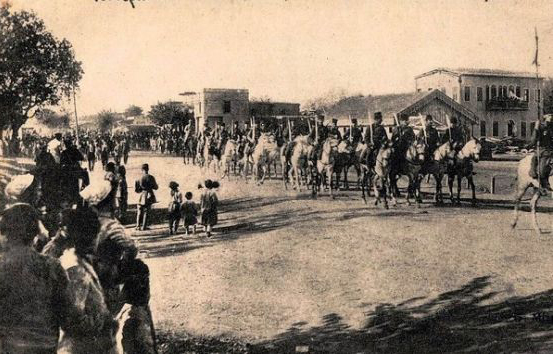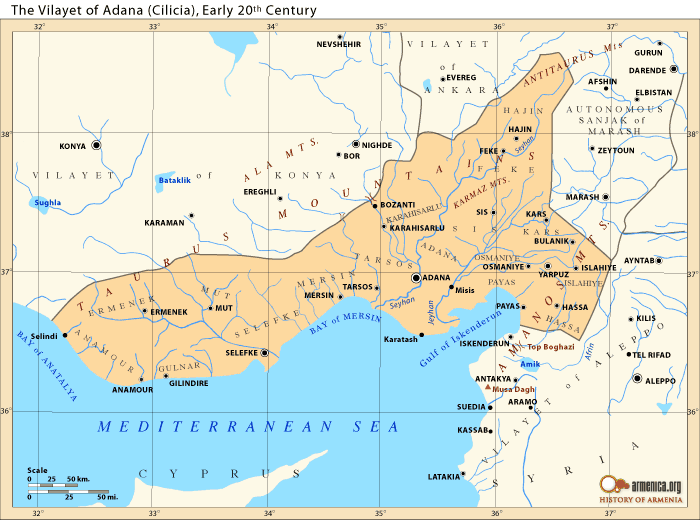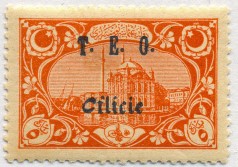ALBUM – View my French Occupation of Cilicia album
Fast Facts
Region: Ottoman Empire / Turkish Area
Group: Post Ottoman Turkey
Classification: Military Occupation
Prior Regime: Ottoman Empire
Key Dates:
1918, Oct 30 – Ottoman Empire unconditionally surrenders to the Allies
1919, Feb 1 – France officially assumes control of Cilicia
1920, Jan/Feb– Nationalist forces under Kemel began “liberating” Cilicia
1921, Oct 21 – French agree to leave Cilicia
1922, Jan – French complete withdrawal from Cilicia
Following Regime: Republic of Turkey
Scott Catalogue: (Cilicia) 1-127, C1-C2, J1-J12
Pick Catalogue: none
History

For more than 600 years, The Ottoman Empire controlled much of the middle east. In its prime, it spanned 3 continents covering most of North Africa, southeastern Europe, Egypt, Arabia and much of modern day Iraq. The Empire, after generations of decay, finally met its demise in World War I, when in Sept, 1918, at the hands of the Allied Expeditionary forces, suffered a devastating defeat in Arara, Palestine. The Ottoman Empire was broken.
One month later, on Oct 30th, 1918, the Ottoman Empire unconditionally surrendered to the Allies onboard the British battleship, the HMS Agamemnon, while anchored in the Turkish port of Mudros. Almost immediately, Allied forces began the process of formally occupying Ottoman territory. To the south and east, the British assumed control of Palestine, Arabia and Mesopotamia, France took Syria, Lebanon, Alexandretta, while to the north and west, the Allies followed by the Greeks gained Thrace and all of the islands in the Aegean.
Cilicia is a large region in the southeastern part of Turkey, known as Adana Vilayet by the Ottomans. For centuries, It had a large Armenian Christian population until the onslaught of the Armenian Genocide, beginning in 1915. During the genocide period, most Armenians in Cilicia were killed, driven out, or fled for their safety. Initially, after the surrender of the Ottomans, the British occupied parts of Cilicia, however on Feb 1st, 1919, control was transferred to the French Occupational Forces. The French established their headquarters in Adana and Mersin and deployed troops as far west as Maras (today Kahramanmaras)
The French initially anticipated the creation of an Armenian state, and encouraged the return of more than 170,000 Armenians to Cilicia to repatriate the land. The Armenians created their own militia, supplementing French forces, which made the Turks vary uncomfortable as they feared reprisals for the genocide.
With the Ottoman Sultanate giving in to all Allied demands, including the partition of Turkey, a strong Nationalist movement arose led by Mustafa Kemal, which resisted any attempt to break up Turkey. In the “war for Turkish Independence”, Kemal regrouped the remaining Ottoman Army, and added a large group of partisans who supported the Nationalist movement. The first target for “liberation” by the Nationalists was Cilicia, when in Jan 1920, Kemal attacked the city of Marash. The French forces were outnumbered and were ultimately forced to retreat. The Armenians who re-settled in the city were massacred.
Turkish Nationalists continued to move southward. Eventually the French realized that they were out-numbered, and could find no support from among the Allies to continue the occupation. On Oct 21, 1921, in the Ankara Agreement, France formally agreed to withdraw from Cilicia. This resulted in the need to again evacuate the Armenian population. The retreat of the French and Armenians was complete in Jan 1922, as Cilicia was brought under the control of the Nationalists of Mustafa Kemal.
Ultimately the Nationalist movement created the Republic of Turkey on Oct 29, 1923, and Mustafa Kemal became its first President. In 1934, the government assembly gave Mustafa Kemal the name Atatürk (“Father of the Turks”).

Stamps
 ALBUM
ALBUM
During the French Occupation period the French forces overprinted stamps for use with the territory. As with most overprints during this era, there is a wide variety of doubles, inverts, misprints and alignments. Postage stamps of Cilicia can basically be broken down into two eras: Ottoman overprints and French surcharges.
See my Album for examples of each of the overprints
OTTOMAN OVERPRINTS (Mar 1919 – Feb 1920)
The first phase of Cilicia postage stamps was the French taking various issues of Ottoman stamps on hand from the local post offices and overprinting them. Five different overprints were issued. All of the overprints come with errors including doubles and inverts.
Overprint #1 (large) – The first overprint was issued on March 4th, 1919. Various issues of stamps of the Ottoman Empire were handstamped “CILICIE”. Two sizes sizes issued. The large overprint measures 18mm in length. A total of 27 stamps and 4 postage dues which were issued with the large overprint
Overprint #1 (small) – On Mar 14, 1919, ten days after the first overprint, a second set of handstamped stamps were issued with a smaller “CILICIE” measuring 16mm instead of 18mm in length. Eleven stamps (plus some perf varieties) and 4 postage dues which were issued with the 16mm handstamp.
Overprint #2 – On April 1, 1919, the French issued another handstamped overprint with “Cilicie” printed in a cursive font. Also, the new overprint was applied to various stamps of the Ottoman Empire. A total of 19 stamps and 4 postage dues which were issued with overprint #2
Overprint #3 – On May 1, 1919, the the last of the Ottoman Overprints to be handstamped was issued. The handstamp added the initials “T.E.O.” above the cursive “Cicilia” overprint. T.E.O. stands for Territoires Ennemis Occupes, (or Occupied Enemy Territory in English). Only one stamp was issued with this overprint.
Overprint #4 – On May 1, 1919, the French issued another overprint, this time it was probably overprinted on the stamp by lithograph. The overprint: “T.E.O // Cilicie” was applied lithographically in black, blue or red. Multiple alignments and variations in typeset have been observed. A total of 21 different stamps were issued.
Overprint/Surcharge #5 – The last of the Ottoman overprints, were also surcharges on two stamps issued in Feb, 1920. As Ottoman postage stamp supply was running low, the French took available stocks of fiscal stamps used to seal cigarette boxes and overprinted them in blue around the four sides of the stamp with “OCCUPATION // MILITAIRE // FRANCAISE // CILICIE”, and then applied one of two surcharges in the middle. Various misspellings, print sizes, double and triple surcharges, alignments have been recorded.
FRENCH SURCHARGES (Mar 1920 – Jan 1922)
Having exhausted up all of the Ottoman Stamps in the local post offices, Multiple Configurations were suthe French began surcharging Stamps of France for use in the Occupied Territory.
Surcharge #6 – The first French surcharge was a single issue on a Stamp from the French offices of the Levant. Issued in Feb 1920, the stamp was overprinted “T.E.O. // 20 // PARAS”. This is the first stamp issued that didn’t contain the word “Cilicie”.
In March, 1920, the French began to use the designation O.M.F. standing for Occupation Militaire Francaise. Three different configurations of were printed.
Surcharge #7 – The 3 line configuration was surcharged reading “O.M.F. // Cilicie // (plus the surcharge)” Nine stamps were surcharged with this configuration.
Surcharge #8 – The 4 line SAND EST configuration was surcharged reading “O.M.F. // Cilicie // SAND. EST. // (plus the surcharge)” “SAND EST” stands for Sandjak de l’Est (Eastern County). Seven stamps were surcharged with this configuration.
Surcharge #9– The 4 line configuration was surcharged reading “O.M.F. // Cilicie // (surcharge number) // (surcharge currency)”. Nine regular issue stamps and four postage dues were issued. There were two different runs of this configuration, on with a 1mm gap between the number and the currency, and one with a 2mm gap.
Surcharge #10 – Issued July 15, 1920, two very rare French Air Post stamps were overprinted “POSTE / PAR / AVION” within a box for Air Mail.
French Occupation stamps were used until the withdrawal of French forces in Jan, 1922.
Banknotes
Currency of the Ottoman Empire was used during the occupation period
Links
The Struggle for Mastery in Cilicia: Turkey, France, and the Ankara Agreement of 1921
Cilicia Under French Mandate , 1918-1921
Franco Turkish War – Wikipedia
Cilicia Stamps from bigblue1840-1940.blogspot.com





Thank you for an excellent web site and album pages – which have helped be to identify a stamp just discovered unexpectedly amongst my own collection. This is a 1920 French Cilicia stamp (25c sower overprinted 1 piastre), noticed only because I was checking it closely with a glass for granite paper and date of postmark. SG don’t seem to recognise this regional occupation issue at all.
My stamp is definitely on granite paper but fits your 122f example with 1 – 1.5 mm spacing between ‘Cilicie’ and the ‘1’ but which you mark as ‘regular paper’; it is not 121 with the wider spacing. Perhaps mine is 122 a, b, c, d or e (whatever these may be) but these do not appear in your album – I am not surprised as these overprints do not appear to be very common. I lack any Scott catalogue to delve further but at least I am somewhere near with it.
Thank you and best wishes
Hello Rodrick
Welcome to DCStamps. Cilicia is a very interesting country, with a sad history, and fascinating stamps. Scott does a pretty good job of helping distinguish between variations.
Normally these stamps were issued on grayish (GC) paper. Here is how Scott (2018 Classics Edition) makes the variation designations for #122.
FIRST SETTING 1.75-2.00 mm spacing between “Cilicia” and the value
122 – grayish (GC)
122a – double surcharge
122b – inverted surcharge
122c – first “S” in “PIASTRES” inverted
SECOND SETTING 1.00-1.50 mm spacing between “Cilicia” and the value
122d – grayish (GC)
122e – inverted surcharge
122f – ordinary paper
The way you described your stamp, it would be a #122d, cataloged at $0.95
By the way, when I looked closer at the #122 in my album, I realized that it has the inverted “S” in “PIASTRES”. Therefore it is in reality a 122c – Wow, it just jumped in catalog value from $2.00 to $55.00. Thanks for making me re-look again.
Hope this helps, and look forward to haring from you again at DCStamps.
Cheers
Michael
Hello–I love “Dead Countries”. I was a moderately serious stamp collector–grew up collecting stamps, was always interested in obscure geography and always loved documenting countries that no longer exist. I never heard of the formal or informal name of Dead Countries but that is perfect. I am about to retire and was thinking of activities to keep me from getting stir crazy and thought about getting more into stamps. I was looking through eBay at stamp collections and trying to think of a topic that was engaging. Not Disneys, Christmas stamps, Kennedys, etc. I saw a few places that I had not thought of/heard of for a long time, and that was just getting my juices flowing. Then I saw a mention of French Cilicia, which I had never heard of. I looked that up on Google and came across this site. Fascinating history and fascinating stamps. Sign me up. I will need to figure out how to sift through broad collections to get specifics but look forward those efforts. Anyway, I don’t know what your process is, but please include me in your communications. Thanks. Steve Miller
Hi Steve
Welcome to DCStamps. I think you were bitten by the Dead Countries bug. Welcome aboard. Hopefully you will read the first issue of the new DCStamps Investigator “blog”. I will be using that to help build the foundation for a Dead Countries group. I will definitely add you to the list of names.
Don’t be a stranger at DCStamps.
Michael
Hi, I came across seven french stamps withthe overprint Cilicia,and found the history of these stamps interesting.
Hi and welcome to DCStamps
Cilicia has a very interesting history, and all of the overprints help tell the tragic story of this region.
I am glad you found it interesting.
Regards
Michael
Cilicia is fascinating on two fronts: the brutal history (Armenians), and the myriad overprinted stamp issues.
Thanks Michael for a particularly illuminating description of the overprints, which are then nicely illustrated with your digital album.
For myself, Cilicia remains a bit of a challenge with all the overprints, and the caution regarding counterfeits.
And yes, I would love to be a part of the “Dead Countries” Society , and perhaps I could contribute in some way.
Hi Jim
Thanks for your comments. I found Cilicia a particularly difficult country as there is very little information available. I particularly want to understand why there were so many different overprints issued in such a short period of time. (both on Ottoman and French Stamps). There is a book I will check out from APS by Max Mayo when I have some time, and I will speak to folks from the Ottoman Society when I am in NY2016.
Also, I will add you to the list on the Dead Country Group, and send you an email separately.
Thanks for your usual great insights.
Michael